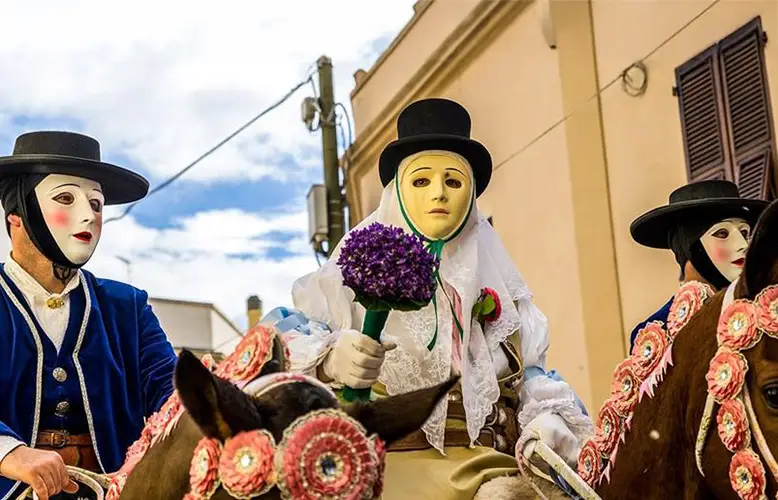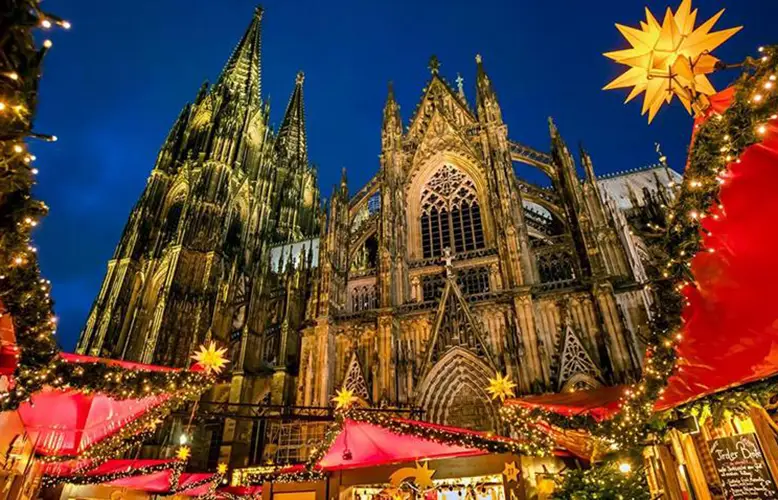
Tis’ (almost) the season! The holidays are around the corner, which has inspired us to reflect on the many different holiday celebrations that take place through the year both in our own backyard and world-wide. In recognition of this, we’ve pulled together some of the most exciting holiday-focused trips Wilderness Travel offers, from exploring Pagan Festivals of Sardinia to taking in a Bhutanese Tsechu, the Hindu festival of Kumbh Mela to perusing Europe’s iconic Christmas markets. The one thing these trips all have in common? They mark important occasions worldwide and are sure to intrigue the adventurous traveller in search of cultural immersion.
Read below to learn more about intriguing holidays, vibrant festivals, and Christmas markets which all center on the celebration of import cultural traditions, events, and days. These include:
- The Kumbh Mela Festival, a Hindu celebration in India
- Sardinia’s Pagan Festivals, celebration of traditional pagan rituals in Sardinia
- Tsechu Fesitval, a buddhist celebration in Bhutan
- European Christmas Markets, a cultural event across Western Europe
- Naadam Festival, a Mongolian celebration of national pride and traditions
- Akwasidae Fesitval, an homage to Ashanti ancestry and community
- Tiji Festival, a Nepalese celebration in Lo Manthang in the region of Mustang

Kumbh Mela, an important Hindu celebration, is the world’s largest congregation of religious pilgrims. Based on the Hindu lunisolar calendar and the relative astrological positions of Jupiter, the Sun, and the Moon, Kumbh Mela is celebrated approximately every 12 years to mark the full revolution of Brihaspati (in English, the planet Jupiter). On these occasions, millions will gather on the sacred Ganges River for the opportunity to renew themselves through bathing in the holy water at this auspicious time. Devotees believe that by doing this, they will be washed of their sins and liberated from the eternal cycle of birth and death.
In 2025, Wilderness Travel is offering a special trip to explore the living traditions of this important Hindu festival with special guides and lecturers that include Lakshmi Singh, a disciple of Advaita Vedanta Hinduism, sadhus (holy men), and spiritual leaders. These cultural experts will help interpret and connect guests to the festivities and lead visitors in a “Death and Rebirth Night Walk” in holy Varansi, Boat along the Ganges at dawn to observe pilgrims at prayer, and guide guests through the busy festival grounds.
Although a part of Italy, Sardinia is well known for its distinct culture and history, including its Pagan festivals and traditions that date back 2000+ years which are still marked annually. Of particular note is the festival of Mamuthones, a traditional ceremony undertaken to banish the winter and welcome the spring. The festival includes two contrasting but equally important characters, the Mamuthones who represent the darkness of winter and the Issohadores that represent the light and hope of spring. During this festival, Mamuthones represent the inhabitants of the kingdom of the dead, dressed in costumes of black sheepskins, up to 60 lbs of heavy brass cowbells, and somber black wooden masks. By contrast, the Issohadores, who represent the spring, dress in markedly lighter and cheerier red tunics. Once the ceremony begins, the Mamuthones march from the largest church led by an Issohadores, lighting bonfires on their way to the largest of them all in the village square.
Wilderness Travel is offering a fascinating discovery of the captivating Pagan festivals of Sardinia, celebrations that hold true to their Sardinian roots. This includes the Mamuthones carnival, the Carrela è Nanti, where horses are ridden wildly through the narrow streets of Santu Lussurgiu in daring acts of bravery and skill; the Sartiglia, a reenactment of a medieval tournament on horseback, complete with reverberant drums and cheering crowds; and the carnival in Ovodda, culminating with a huge bonfire in the main square. This is a chance to experience the real Sardinia—the deep “dark heart” of the interior, where few tourists venture, and where the locals proudly keep the oldest traditions. Along the way, enjoy short hikes and the incredible culinary traditions of Sardinia.
Tsechu refers to any of the annual religious festivals celebrated throughout the year in Bhutan. A Tsechu is held on the tenth day of a month in the lunar Tibetan calendar throughout Bhutan, with the Timpu Tsechu and Paro Tsechu being some of the largest and most attended in the small Himalayan country. The celebration serves as a large social gathering, bringing people from remote and spread-out villages together. The piece-de-resistance of any Tsechu is the Cham, the costumed, colourful presentations that typically depict teachings and lessons from Buddhist saints through choreographed song and dance.
There are several Tsechus taking place throughout the year in Bhutan, with Wilderness Travel offering departures that take in different festivals. On this cultural exploration take in a Tsechu, learning about the significance of the celebration for Bhutanese buddhism, enjoying the beauty of Bhutan’s unparalleled and spiritual places, and spend time in Bumthang region, the spiritual center of the kingdom. Different departures take in the Punakha Festival, Paro Festival, Thimphu Festival, Prakher Festival, Jakar Festival, and Black Necked Crane Festival.

Christmas and Holiday Markets
Northern Europe is well known for its iconic and cozy holiday markets, with each country bringing its own flare to the tradition. The Christmas market evolved out of the mercantile traditions of medieval Europe, with some of the oldest ongoing Christmas markets including the Dresden Striezelmarkt (established 1434), and the Nuremburg Christkindlesmarket (established 1628). We know that these markets started out in Germany, before spreading to the German speaking areas of Italy, Switzerland, and France before spreading further afield to the modern Christmas markets of today. The following trips include ample time for exploration of some of Europe’s most celebrated modern markets, including Austria, Germany, Hungary, Switzerland and the Netherland’s most festive and cheerful markets.
European Christmas Markets by Rail
Journey between Central Europe’s classical Christmas Markets aboard the nostalgically appointed Golden Eagle Danube Express. Weave through the snow-capped peaks of the Austrian Alps before enjoying the joys of the festive season with this expertly curated itinerary perfectly designed to indulge the senses at the most wonderful time of the year. Signature Golden Eagle Luxury Trains experiences include a magical concert of Viennese Christmas folk songs, a traditional “Fiaker” (horse-drawn carriage) through Vienna’s grand boulevard, and a tasting session of the traditional Pirker gingerbread in front of the iconic St Stephen’s Cathedral. This rail journey operates between Budapest to Munich.
Travel back through centuries walking along cobblestone streets through grand cities and historic towns bedecked with twinkling Christmas trees and lined with wooden huts gleaming with handcrafted treasures. Iconic Christmas Markets are plentiful and are on full display including Budapest’s Vörösmarty Square, where all products sold in the market are guaranteed as traditionally handmade; Vienna with its impressive Christmas Markets that seem to majestically appear around every corner; Nuremberg’s festive Christkindlesmarkt, the largest Christmas Market in Germany; and Regensburg’s Christmas Market at Thurn and Taxis Castle, considered one of Bavaria’s most beautiful and romantic. Sparkling lights; the festive sounds of children dressed as angels singing carols; enticing smells of hot-mulled wine, roasted chestnuts, sausages and sweet treats of every kind; and timeless wonders are a feast for the holiday senses.
Christmas Markets on the Rhine
Experience the deep-rooted holiday traditions of Europe at its most festive time of year. From the iconic canals of Amsterdam to Switzerland’s glittery cities, Lucerne and Zurich, get caught up in the magic of the holidays with visits to some of the world’s most timeless Christmas Markets. Warm up with a mug of steamy glühwein while at the Cologne Christmas Market located in front of its UNESCO-designated Gothic cathedral. Let the “Capital of Noël,” Strasbourg, the oldest and largest Christmas Market in France, captivate the senses as it has for so many others. Meander through Heidelberg’s majestic Christmas Market nestled idyllically among the historic squares of the Old Town. While in Gengenbach, marvel at the world’s largest Advent calendar, where every evening at 6:00 pm, the brightly lit windows of the neo-classical town hall open and behind each one is a picture by a famous artist, such as Andy Warhol. Cherish all the glory of the season in grand European style while cruising along the Rhine.
Mongolia’s National Cultural Celebration: Naadam Festival
Every year, Mongolia celebrates the festival of Naadam nationally through July and August. The festival is a celebration of traditional Mongolian culture, highlighting the pastoral and nomadic heritage of the country through traditional games, storytelling, song, poetry, cuisine, and through special rituals and practices only performed during Naadam. The festival centers on three traditional games considered essential for survival and prosperity in traditional Mongol culture: horseracing, wrestling, and archery. Athletes compete across Mongolia in feats of strength and contests in these areas, receiving recognition, praise, and financial reward for their endeavours. It is not uncommon for ritual songs and poems to be dedicated to winners of the years’ events. The cultural traditions of Khöömei overtone singing, Bie biyelgee dance and Morin khuur fiddle also feature prominently during Naadam. Colourful and completely distinct, everyone is encouraged and allowed to participate in Naadam and the festival serves as an important opportunity to pass down cultural tradition and knowledge to the next generations.
Travel with Wilderness Travel to see the wild horses of Khustain Nuruu National Park and explore the ruins of ancient Karakorum, once the capital of Genghis Khan’s empire. In the Gobi Desert, hike in the dramatic gorge of the Yol Valley, watch the sun set over the fabled Flaming Cliffs, and even ride a Bactrian camel. Along the way, experience the warth of Mongolia’s culture spending nights in cozy traditional gers (yurts) and, of course, attend the Naadam festival, taking in archery, wrestling, cross-country horse races, and the beautiful cultural traditions and craftsmanship of the area.
Honoring Ashanti Ancestors: Akwasidae Festival in Ghana
Celebrated by the Ashanti people of Ghana, the Akwasidae Festival is a showcase of the profound honor, respect, and reverence for ancestry and community spirit prominent in Ashanti culture. Celebrated for centuries, the festival continues to this day and includes important traditional rites and rituals like drumming, dancing, and singing, to pay homage to Abosom (lesser gods in the Akan tradition) and Nsamanfo (spiritually cultivated ancestors). During the festival, special food offerings are usually made, including special items such as eto (mashed African yam) garnished with hard-boiled eggs, which are meant to symbolize reverence and gratitude towards ancestral spirits. At its core, the festival of Akwasidae serves as a vibrant and vital opportunity to commemorate and honor ancestors, and strengthen familial and community bonds. A cornerstone of the Akwasidae festival is the assembly of Asantehene (King of Ashante) and the display of the golden stool, an important symbol in Ashanti culture said to possess the sunsum (soul) of the Ashanti people. During this special part of the festival, Asantehene takes in singing, drumming, and dancing ceremonies, greets his subjects, and visits the Bantama Mausoleum to pay respect to his ancestors, their golden stools, and remains.
Wilderness Travel’s cultural odyssey across Togo, Benin, and Ghana brings guests into the fascinating world of the Ashanti people and other cultural traditions of this unique area of the world. Along the way, meet unforgettable people including the Tamberma, with their fairytale clay castles on the wooded savannas, and the Ashanti, whose kingdom is still ruled by a revered monarch in the city of Kumasi. In the heart of voodoo country, visit practitioners, watch trance-dances, and learn about the awesome power of the voodoo spirits. Of course, a key aspect of the journey spends time taking in the Akwasidae Festival in Kumasi.
The Tiji Festival is a Buddhist celebration and religious pilgrimage that takes place every May in the walled city of Lo Manthang, a small community located in what was once the forbidden Kingdom of Lo, in the remote kingdom of Mustang in northern Nepal. The ceremony includes offerings and prayer from local monks, song and music including dungehen (traditional long copper horns), accompanied by beating of drums and cymbals, and three days of dance that tell a traditional tale. The ceremony has been performed in various forms for several centuries, and after three days of masked dancing, results in the dhakey or slaying of an evil demon by the deity Dorje Shunu. Initially a religious ceremony to ward off obstacles and suffering, it has also come to symbolize the strength and hope of the people of Lo, and many of them make the annual pilgrimage to witness the spectacle.
Explore the Tiji Festival and distinct culture of this fascinating corner of Nepal on departures of Nepal: Lodge to Lodge Hiking in Upper Mustang. Part of Nepal since the 18th century, Mustang is a time capsule of ancient Tibetan heritage on what was once a vital trade route from Tibet to Nepal. On day hikes and 4WD trails, explore whitewashed cliff villages and eerie “meditation sky caves” surrounded by Mustang’s otherworldly moonscape of rock chimneys and ravines flanked by majestic snow peaks. Of course, visit Lo Manthang to take in the multi-day Tiji Festival, with its chanting monks, clanging cymbals, and leaping masked dancers—it’s an incredibly colorful event in one of the most extraordinary places on Earth.





